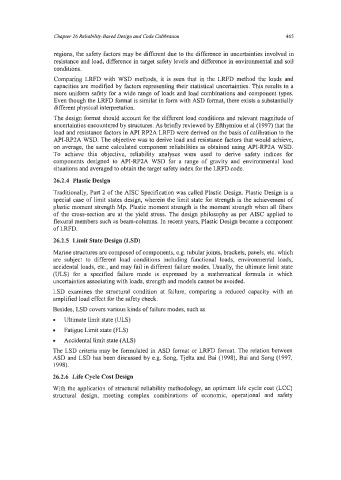Page 489 - Marine Structural Design
P. 489
Chapter 26 Reliabiliiy-Based Design and Code Calibration 465
regions, the safety factors may be different due to the difference in uncertainties involved in
resistance and load, difference in target safety levels and difference in environmental and soil
conditions.
Comparing LRFD with WSD methods, it is seen that in the LRFD method the loads and
capacities are modified by factors representing their statistical uncertainties. This results in a
more uniform safety for a wide range of loads and load combinations and component types.
Even though the LRFD format is similar in form with ASD format, there exists a substantially
different physical interpretation.
The design format should account for the different load conditions and relevant magnitude of
uncertainties encountered by structures. As briefly reviewed by Efthymiou et a1 (1997) that the
load and resistance factors in API RPZA LRFD were derived on the basis of calibration to the
API-RP2A WSD. The objective was to derive load and resistance factors that would achieve,
on average, the same calculated component reliabilities as obtained using API-RP2A WSD.
To achieve this objective, reliability analyses were used to derive safety indices for
components designed to API-RP2A WSD for a range of gravity and environmental load
situations and averaged to obtain the target safety index for the LRFD code.
26.2.4 Plastic Design
Traditionally, Part 2 of the AISC Specification was called Plastic Design. Plastic Design is a
special case of limit states design, wherein the limit state for strength is the achievement of
plastic moment strength Mp. Plastic moment strength is the moment strength when all fibers
of the cross-section are at the yield stress. The design philosophy as per AISC applied to
flexural members such as beam-columns. In recent years, Plastic Design became a component
of LRFD.
26.2.5 Limit State Design (LSD)
Marine structures are composed of components, e.g. tubular joints, brackets, panels, etc. which
are subject to different load conditions including finctional loads, environmental loads,
accidental loads, etc., and may fail in different failure modes. Usually, the ultimate limit state
(ULS) for a specified failure mode is expressed by a mathematical formula in which
uncertainties associating with loads, strength and models cannot be avoided.
LSD examines the structural condition at failure, comparing a reduced capacity with an
amplified load effect for the safety check.
Besides, LSD covers various kinds of failure modes, such as
Ultimate limit state (ULS)
0
Fatigue Limit state (FLS)
0
Accidental limit state (ALS)
The LSD criteria may be formulated in ASD format or LRFD format. The relation between
ASD and LSD has been discussed by e.g. Song, Tjelta and Bai (1998), Bai and Song (1997,
1998).
26.2.6 Life Cycle Cost Design
With the application of structural reliability methodology, an optimum life cycle cost (LCC)
structural design, meeting complex combinations of economic, operational and safety

